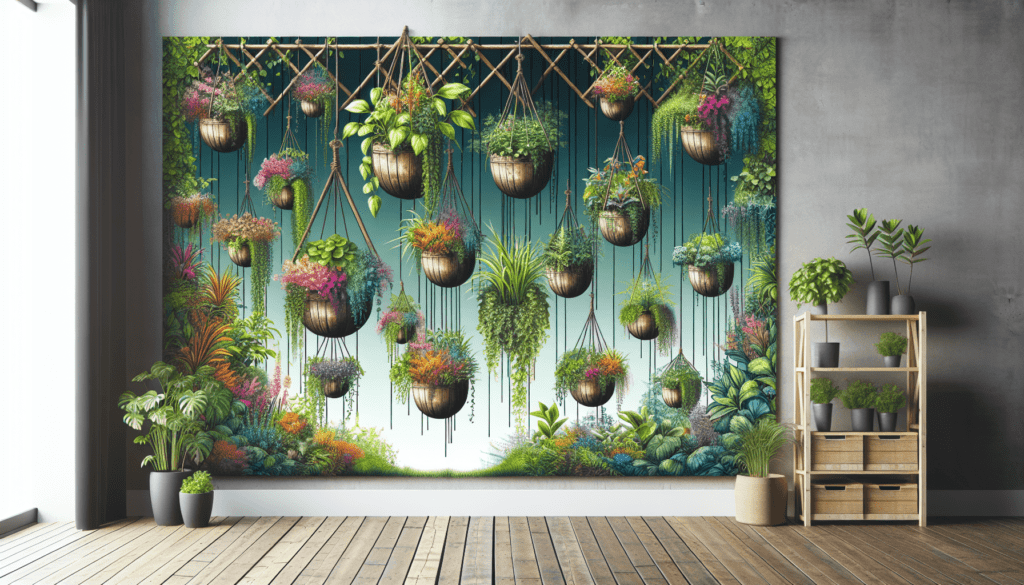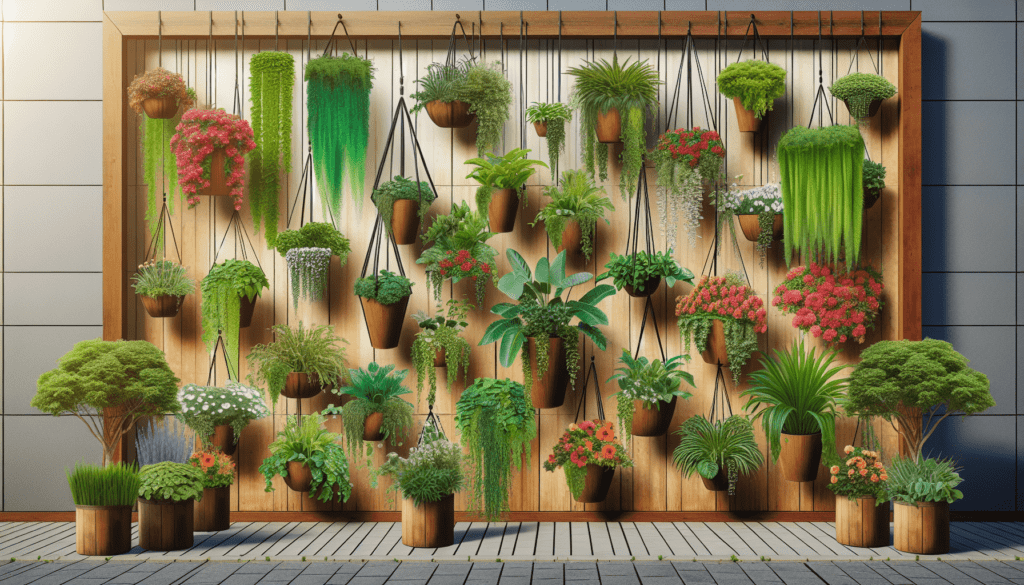Welcome to the wonderful world of vertical gardening! In this article, you will learn all about the techniques and plant selection needed to create your very own beautiful vertical garden. Whether you’re a seasoned gardener looking to try something new or a beginner wanting to add some greenery to your space, this guide will provide you with the necessary information to get started. From choosing the right plants to understanding the best practices for vertical gardening, you’ll be well-equipped to create a stunning garden that will thrive and bring you joy for years to come. So grab your gardening gloves and let’s get started on this exciting green journey together! Have you ever dreamed of transforming a blank wall into a lush garden oasis? With a vertical garden, you can do just that! This innovative gardening technique allows you to grow plants vertically, maximizing space and creating a stunning display. In this article, we will explore the techniques and plant selection involved in growing a vertical garden. From choosing the right plants to maintaining your garden, we will cover everything you need to know to create a thriving vertical garden.

Getting Started: Why Choose a Vertical Garden?
Vertical gardening has gained popularity in recent years due to its numerous benefits. Not only does it allow you to grow more plants in a small space, but it also adds a decorative element to any indoor or outdoor area. Vertical gardens are perfect for urban dwellers with limited outdoor space or for adding greenery to a bare wall. By utilizing vertical space, you can enjoy the beauty of nature in places where traditional gardens may not be feasible.
“Vertical gardens are a great way to add a touch of nature to any space while maximizing limited square footage. Whether you’re looking to create a stunning focal point or simply want to liven up a dull wall, a vertical garden is the perfect solution.”
Choosing the Right Plants for Your Vertical Garden
Selecting the right plants is crucial to the success of your vertical garden. Not all plants are well-suited for vertical growing conditions, so it’s important to choose varieties that thrive in a vertical environment. When selecting plants, consider factors such as light requirements, water needs, and growth habits. Opt for plants that are well-suited to your climate and the conditions of your vertical garden.
“Choosing the right plants is key to a successful vertical garden. Look for varieties that will thrive in vertical growing conditions, such as trailing or climbing plants that can spread out and fill the space while thriving in limited soil.”
Techniques for Building a Vertical Garden
There are several techniques for creating a vertical garden, ranging from DIY projects to pre-made systems. Whether you prefer a customized design or a ready-to-use kit, there are options to suit every skill level and budget. Before building your vertical garden, consider factors such as sunlight exposure, watering requirements, and maintenance needs. Choose a location that receives adequate light for your chosen plants and ensure easy access for watering and pruning.
“From simple hanging planters to intricate living walls, there are numerous techniques for building a vertical garden. Consider your skill level and budget when choosing a method, and be sure to select a location that meets the needs of your plants.”
Vertical Garden Techniques:
| Technique | Description |
|---|---|
| Living Wall Systems | Pre-made systems that feature built-in irrigation and support structures for creating a lush vertical garden. |
| DIY Pallet Garden | Upcycle a wooden pallet into a vertical planter by adding shelves or pockets for planting a variety of herbs. |
| Hanging Planters | Simple and affordable, hanging planters are a versatile option for creating a vertical garden indoors or outdoors. |
| Trellis or Grid System | Install a trellis or grid on a wall or fence and train climbing plants to grow vertically for a stunning display. |
| Stackable Planters | Stackable planters allow you to create a vertical garden with multiple tiers, perfect for small spaces or balconies. |
Planting and Maintaining Your Vertical Garden
Once you’ve chosen your plants and built your vertical garden, it’s time to start planting and maintaining your new green oasis. Proper planting techniques are essential for the health and growth of your plants, so be sure to plant them at the correct depth and spacing. Regular watering, pruning, and fertilizing are also crucial for maintaining a thriving vertical garden. Monitor your plants for signs of pests or disease and take prompt action to address any issues.
“Planting and maintaining your vertical garden is key to its success. By following proper planting techniques and providing regular care, you can ensure that your plants thrive and your garden remains healthy and vibrant.”
Vertical Garden Maintenance Tips:
-
Watering: Check soil moisture regularly and water plants as needed, ensuring even hydration throughout the vertical garden.
-
Pruning: Trim back overgrown or damaged foliage to promote new growth and maintain the shape of your plants.
-
Fertilizing: Feed your plants with a balanced fertilizer to provide essential nutrients for healthy growth and vibrant blooms.
-
Pest Control: Monitor your plants for pests such as aphids or spider mites and treat infestations promptly to prevent damage.
Planting and Maintenance Checklist:
-
Planting Depth: Ensure plants are planted at the correct depth to allow roots to establish and grow.
-
Spacing: Provide adequate spacing between plants to allow for air circulation and prevent overcrowding.
-
Mulching: Apply mulch around the base of plants to retain moisture and suppress weeds in your vertical garden.

Plant Selection for Vertical Gardens
When choosing plants for your vertical garden, consider a mix of trailing, climbing, and compact varieties to create visual interest and fill the space. Trailing plants such as ivy or ferns are ideal for cascading down walls, while climbing plants like jasmine or clematis can be trained to grow vertically. Compact plants such as succulents or herbs are perfect for small pockets or containers in a vertical garden. Select a variety of plants with different textures, colors, and growth habits to create a diverse and captivating display.
“Choosing a mix of trailing, climbing, and compact plants will add dimension and visual interest to your vertical garden. Select a range of colors and textures to create a vibrant and dynamic display that will thrive in a vertical environment.”
Plant Selection Tips:
-
Trailing Plants: Ivy, pothos, ferns
-
Climbing Plants: Jasmine, clematis, morning glory
-
Compact Plants: Succulents, herbs, small flowering perennials
-
Colorful Plants: Caladium, begonia, coleus
-
Textured Plants: Echeveria, bird’s nest fern, moss
Vertical Garden Design Ideas
There are endless design possibilities when it comes to vertical gardens, from sleek and modern to whimsical and eclectic. Whether you prefer a minimalist monochrome palette or a riot of colors and textures, there is a design style to suit every taste. Consider incorporating unique elements such as reclaimed materials, decorative pots, or lighting to enhance the beauty of your vertical garden. Experiment with different layouts and plant combinations to create a personalized and visually stunning display.
“Vertical gardens offer endless design possibilities, allowing you to express your creativity and style. Whether you prefer a contemporary look or a bohemian vibe, there are design ideas to suit every taste and space.”
Vertical Garden Design Styles:
-
Minimalist Monochrome: Create a sleek and modern design with a limited color palette and clean lines.
-
Bohemian Chic: Embrace a laid-back and eclectic style with a mix of colors, textures, and plant varieties.
-
Rustic Charm: Add a touch of rustic elegance with reclaimed wood, metal accents, and vintage planters.
-
Contemporary Zen: Achieve a sense of serenity and balance with a minimalist design and a focus on natural materials.
Troubleshooting Common Vertical Garden Issues
Even the most well-maintained vertical garden may encounter problems from time to time. From pests and diseases to environmental factors, there are several common issues that vertical gardeners may face. By being proactive and observant, you can address problems early and prevent them from affecting the health of your plants. Regular monitoring and maintenance are key to keeping your vertical garden thriving and beautiful year-round.
“Despite your best efforts, your vertical garden may encounter issues such as pests, diseases, or environmental stress. By staying vigilant and taking prompt action, you can address common problems before they escalate and maintain a healthy garden.”
Common Vertical Garden Issues:
-
Pests: Aphids, spider mites, and whiteflies can infest plants in a vertical garden, causing damage to foliage and flowers.
-
Diseases: Fungal infections, root rot, and powdery mildew can affect plants in a vertical garden, leading to wilting and discoloration.
-
Watering Problems: Overwatering or underwatering can cause stress to plants in a vertical garden, leading to root rot or dehydration.
-
Temperature Extremes: Excessive heat or cold can stress plants in a vertical garden, affecting their growth and overall health.
Conclusion
Growing a vertical garden is a rewarding and creative way to introduce greenery into your home or outdoor space. By choosing the right plants, building a well-designed vertical garden, and providing proper care, you can create a stunning display that will thrive and flourish year-round. Whether you’re a seasoned gardener or a beginner, vertical gardening offers endless possibilities for expressing your creativity and style. With the techniques and plant selection outlined in this article, you can confidently embark on your vertical gardening journey and enjoy the beauty of a lush garden in any space.

